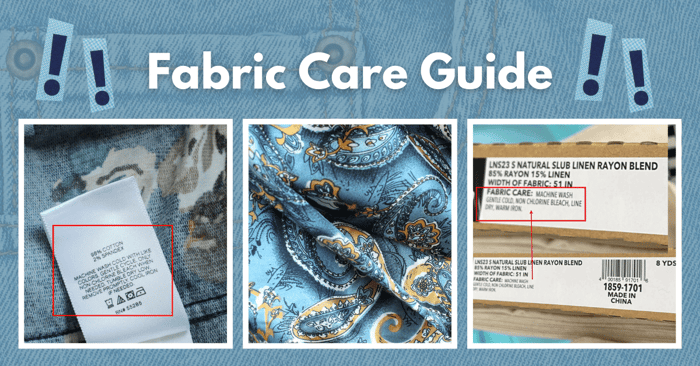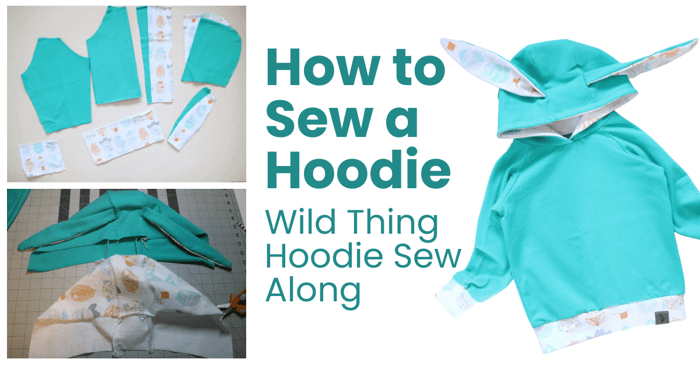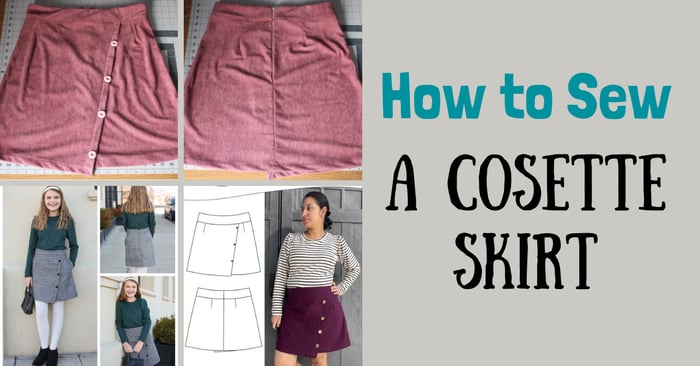
Fabric Care Guide
Today we have a handy fabric care guide. What's the optimal approach to caring for newly purchased fabrics? How important are care labels? Are all fabrics washable? Is it safe to wash wool? These are just a few of the questions we'll address in this article. Following these fabric and garment care instructions will not only ensure cleanliness but also preserve their shape and vibrant colors.
But...sometimes it's nice to be a little more specific depending on the type of fabric you have. This fabric care guide will help answer some questions.
Pre-Washing Fabric Before Sewing
For starters, at Peek-a-Boo Pattern Shop and KnitFabric.com, we always recommend pre-washing and drying your fabric before beginning your project, unless the fabric description specifically notes to not machine wash. Wash fabrics with similar colors and an appropriate water temperature (cold for darks). For cotton based knits, you can expect 2-3" shrinkage/yard. For best results, wash all finished garments inside out on cold. Tumble dry low.

Why prewashing fabrics is not really a waste of time
Prewashing fabrics helps to eliminate chemicals and dyes added to the yarn during manufacturing, as well as to manage shrinkage, as all fabrics have some degree of shrinkage.
During the manufacturing process of fabric, "sizing" is applied as a protective measure to prepare the yarn for weaving. This involves applying chemicals like protective adhesives to enhance yarn strength and facilitate easier handling during manufacturing. Additionally, certain fabrics, such as denim and flannel, are prone to shrinking after washing, causing the fibers to tighten. If you sew a garment using fabric that hasn't been prewashed, you can expect the garment to potentially become shorter, tighter, or a combination of both due to this shrinkage.
Furthermore, some fabrics tend to bleed color, making it essential to remove excess dye during prewashing to prevent staining other garments in the future. While it's generally advisable to prewash fabric once before sewing, there are times when prewashing is repeated, particularly for certain fabrics, to soften the fabric and ensure all shrinkage is eliminated.
A useful tip: Certain fabric types like linen and cotton may fray or unravel during washing. To prevent this, many sewists recommend overlocking or zig-zag stitching both raw edges of the fabric or sewing the edges together. After washing, the seam or serger stitches can be removed from the fabric.
Are All Fabrics Washable?
Unfortunately, not all fabrics are suitable for washing, which is why it’s important to check care labels and avoid washing fabrics that should only be dry-cleaned. Fabrics like certain types of leather, viscose, fur with skin, suede, some wools, and garments with specific structural elements such as jackets, coats, and blazers are typically labeled as "dry clean only" and are best handled by professionals.
Additionally, certain fabrics used in sewing, such as stabilized fabrics with interfacing, should also avoid washing as they may shrink or lose their fusing properties.
Hand Washing vs Machine Washing
Hand washing is a gentle method for washing delicate fabrics and woolens, as well as everyday wear fabrics like cotton and linen. It allows for more control over the process. However, this doesn't imply that machine washing is harmful to fabrics. In some cases, particularly with very delicate fabrics, hand washing might be preferred to avoid any potential damage that a washing machine could cause.
Nevertheless, modern washing machines offer numerous benefits such as capacity, convenience, and effective cleaning. A balanced approach of both methods could be the most sensible choice. Reserve handwashing for delicate fabrics and use the washing machine for everyday garment washing, benefiting from its efficiency and capacity.
Testing Fabric for Shrinkage
Over time, you'll become familiar with which fabrics tend to shrink more than others. However, when working with new fabrics, testing for shrinkage before cutting and sewing your project may be beneficial.
The shrinkage test is widely used in the textile industry to predict a fabric's performance and ensure it meets the required standards. The method outlined below not only tests for shrinkage but also allows you to check for fabric bleeding at the same time.
- Prepare a fabric sample by cutting a rectangular fabric piece measuring at least 20 cm x 20 cm (8x8 inches).
- Wash and dry the fabric sample to your chosen test method.
- Measure the lengthwise and cross-grain dimensions of the fabric sample using a ruler.
- Calculate the % shrinkage with the below formula.
% shrinkage = pre-wash (inch or cm) – post-wash (inch or cm) /pre-wash cm x 100
For example: A 20 x 20 cm square fabric sample post-wash measured 18.5 cm in lengthwise and 19.7 cm in crossgrain. Both lengthwise and cross-grain shrinkage are calculated using the formula above.
% shrinkage in lengthwise grain = 20-18.5/20×100 =1.5/20×100 = 0.075×100 =7.5 %
% shrinkage in cross-grain = 20-19.7/20×100 = 0.3/20×100 = 0.015×100 = 1.5 %
But what do these numbers mean actually? Let’s say that a 2.5% to 3% shrinkage is an acceptable number in the textile industry. More than that it may cause quite some problems with the length and the fit of the garments.
For example, lengthwise shrinkage affects the length of a garment, and cross-grain shrinkage affects fit at main measuring points such as the waist, bust, and hips.

Drying the Fabric
Drying your fabrics properly is just as important as washing them. Proper drying preserves the feel but also the color of the fabrics after washing. Follow these drying guidelines for various fabric types:
- If air drying hang the fabric away from direct sunlight to prevent fading!
- When using a dryer, ensure it’s set to the correct setting for the fabric type since your fabric can over-shrink if the heat is high.
- Take your fabrics out of the dryer once finished to prevent wrinkling!

Pressing and Storing the Fabric
Once your fabric is dry, the ideal is to fold promptly but that’s not always possible so pressing can be done to remove the wrinkles.
Be aware that the temperature setting you choose depends on the fabric. Test the fabric's heat tolerance and use a pressing cloth to protect delicate or synthetic fabrics from direct contact with the iron.
Fabric and Garment Care Labels
Every fabric or garment comes with a care label crafted by the manufacturer, which provides a set of washing and drying instructions along with symbols. This initial reference point is crucial if you aim to extend the lifespan of your fabrics and your garments.

When it comes to fabric, there's a slight difference and the care labels are written under the fabric bolt label. Among other details, the manufacturer typically includes fabric care instructions specific to that particular fabric. This ensures that you have the necessary information to properly care for the fabric you purchase.

Be sure to take notes or a simple photograph of the label when shopping for fabric, so you'll have a reference for caring for the fabric later. When shopping online, most stores already include a fabric care section under the description, so be sure to check that out as well.
How to Read a Care Label
A care label typically includes instructions for washing, bleaching, drying, dry cleaning, and ironing. Each symbol represents specific care instructions, and while these symbols can vary depending on the country, most manufacturers use a universal set.
It's essential to check the textile care labeling system that corresponds to your country to ensure you have the correct information.
The below care label sheet was created by The American Cleaning Institute and provides comprehensive information and the most common symbols and how to interpret them. You can print this out and keep it in your laundry room for easy reference when needed.


Fabric Care Instructions by Fabric Type
Some of the most common fabrics that we sew garments with and how to specifically care for each one of them:
Cotton fabrics are suitable for both hand and machine washing, although they tend to wrinkle easily. They can withstand tumble drying and ironing at high temperatures without risking damage to the fibers. For white cotton fabrics, it's recommended to wash them in hot or warm water, while colored cottons should be washed in cold water to prevent color fading.

Linen is a durable natural fiber that is safe to wash in the washing machine, however, it’s preferred to be done in a cooler setting. Linen fabric can be air-dried or dried in a drier on medium heat. Ironing is best done at medium to high heat. Linen becomes softer the more times it is washed, that is why some sewers wash it two to three times before sewing the project.

Wool fabrics are always recommended to be dry clean only, even though certain wool garments can be hand washed. Since the shape of the garment but also the fabric can be agitated the recommendation is to dry clean and laid flat to dry. Subjecting wool to a dryer can result in significant shrinking.

Silk is known as a very delicate fabric that can be hand-washed or dry-cleaned. When hand washing, it's essential to use cold water and mild detergents formulated specifically for silk fabrics. After washing, silk should be air-dried or laid flat to dry. Ironing should be avoided unless necessary, and if needed, it should be done on low heat to prevent damage to the fibers.

Leather requires different care compared to other fabrics due to its unique characteristics since it doesn't accumulate dust and dirt in the same manner. Often, simply using a clean cloth is sufficient for cleaning. However, for stains and spots, there are numerous leather cleaning solutions available. It's advisable to leave the cleaning and treatment of leather garments to professionals for the best results and to avoid any potential damage.
Fabric Care Guide for Synthetic Fabrics (Polyester, spandex, acrylic, nylon, acetate)
Synthetic fabrics are typically recommended to be washed in cold water to prevent the weakening of the fabric and the release of microplastics. Being made from artificial fibers, these fabrics tend to possess resistance to both heat and water, making them suitable for cold water washing. Opt for air drying or machine drying on a low heat setting. Given their wrinkle-resistant nature, ironing is often unnecessary for synthetic fabrics.

With numerous other fibers and fiber blends available it’s always best to consult the care labels and follow the manufacturer's instructions for optimal fabric care results.
Thank you for joining us today for our fabric care guide to learn a little more about caring for fabric. Before you leave, join our Facebook Group and follow us on Instagram. Happy Sewing!



